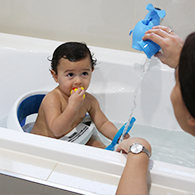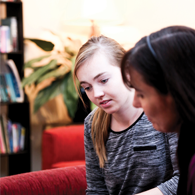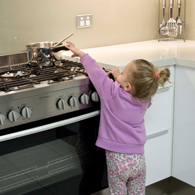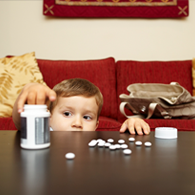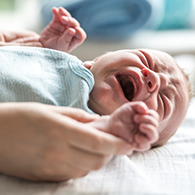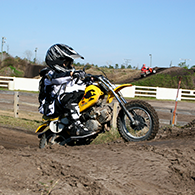Hot water and scalds
What is a scald?
A scald is a burn caused by hot liquid, steam or gas.
How are children injured by hot water?
Burns
Most scalds to children occur in the home and are often caused by:
Hot drinks
- Children can pull or tip hot drinks such as tea and coffee over themselves.
- Children can suddenly reach for hot drinks while they are sitting on an adult’s lap.
- Hot drinks placed on a table with a tablecloth can be pulled over by young children pulling on the tablecloth.
Foods, fats and cooking oils
- Children can get burnt if they are in the kitchen while others are cooking.
- Hot foods such as noodles are a cause of scalds, with the liquid and the food matter spilling on to children’s bodies.
- Saucepan handles and electrical cords left within reach can be grabbed by children and the hot contents and/or appliance pulled down on to the child.
- Children can also get burnt when they reach up to pull hot liquids out of a microwave, or down from the stove.
Hot tap water
- Hot tap-water burns usually happen in the bathroom where bathing water comes from the tap at an unsafe temperature.
- Water at 65ºC produces a full thickness burn in less than a second; at 60ºC it takes five seconds. Water at 50ºC takes five minutes to produce the same depth of burn.1
- Controlling the delivery temperature of hot water in bathrooms to 50ºC helps to reduce scald burns from occurring.
How common are these injuries?
Between July 2012 and June 2017, 1,812 children aged 0-4 years were hospitalised in NSW for a burn2. Many others will have attended an Emergency Department or Medical Centre for treatment of a burn. The majority of burns in this age group happen in the kitchen, with soups, noodles, tea and coffee being among the most common causes of scalds.
Are there laws, regulations or standards for hot water systems?
The joint Australian/ New Zealand Standard, AS/NZS 3500 – Plumbing and drainage, guides how plumbers install taps, showers, bath tubs, hot water systems and drainage systems across the country. AS/NZS 3500.4 – Heated water services requires that newly installed hot water systems delivering water to any outlet primarily used for personal hygiene purposes, such as basins, baths and showers, must be set at a temperature no greater than 50ºC in domestic settings and 45°C in child care, schools, aged care and hospital settings.
The National Construction Code (NCC) is the construction code for Australia and incorporates the Plumbing Code of Australia (PCA) as Volume 3. From 1 May 2019, the NCC (2019) will be adopted by all states and territories.
Older homes may not have the delivery temperature of their hot water systems controlled to a safer temperature, however it is possible to have a plumber add a tempering device.
From July 2012, NSW adopted the PCA requirement for the installation of a temperature control device when replacing or repairing a hot water system.
Remember:
Safety devices
- Control the delivery temperature of hot tap water in bathrooms to a maximum of 50°C. A licensed plumber can install a tempering device to older systems.
- Child resistant taps may stop children from turning taps on but do not reduce the hot water temperature.
Supervision
- Young children should NEVER be left alone in the bathroom or in the care of an older child.
- Take the phone off the hook or turn the answering machine on before running the bath for young children to avoid distraction while children are in the bath.
- Close the door when the bathroom is not in use.
Running a bath
- Always turn on the cold water tap then add hot water when filling a bath. Turn the hot water tap off before the cold water tap when filled. The same applies when taking a shower.
- Always check the temperature before putting a young child in the bath. Use a bath thermometer for accuracy. Dipping your elbow or inside wrist in the water is a guide. A maximum of 40ºC is recommended for small children.
Cooking
- Use the back stove elements to cook.
- Turn saucepan handles so they are out of reach of young children.
- Use a barrier such as a stove guard or safety gate to keep young children away from the stove or out of the kitchen when cooking.
- Place kettles and other appliances to the rear of the bench.
- Empty unused boiled water from the kettle.
- Use a cordless kettle or wind up the cords under the base.
- Do not throw water on burning oil. Water will cause the oil to splatter, spreading the fire and causing serious burns.
- Always drain the water from noodles before eating. Children should eat hot foods at a table so they do not spill them onto themselves.
Microwave
- Do not heat baby bottles in the microwave.
- Always follow the recommended cooking time on labels. Over-heating food and liquids may result in it exploding.
- For older children, make sure microwaves are at a level where children are not reaching above their waist to remove food from the microwave.
Hot drinks
- Do not hold a young child while you have a hot drink.
- Do not leave hot drinks in reach of young children.
- Do not use table cloths as these can be pulled down by young children.
First aid for burns
- Use cool running water on a burn for 20 minutes. This will stop the burning process, cool the burn and can be useful within three hours of a burn.
- Call 000 or seek medical help if you are unsure.
- Never use ice, iced water, cream, toothpaste or butter on a burn as they can make the burn worse.
- Burn creams do not cool the burn and should not be used instead of cool running water.
References
1. Public Health Association of Australia (2016). Hot Water Temperature and Scald Burns Policy. PHAA. Available from: https://www.phaa.net.au/documents/item/1702
2. HealthStats NSW. http://www.healthstats.nsw.gov.au/Indicator/inj_burnhos/inj_burnhos_age_trend
